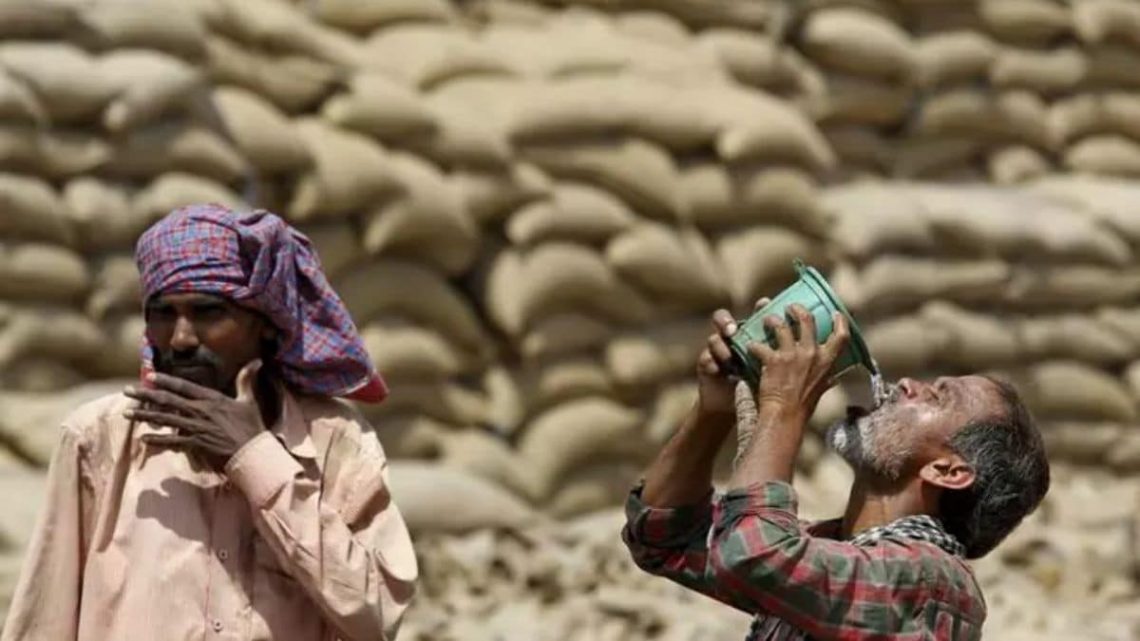The frequency and duration of heat waves have surged with climate change, leading to more frequent hot days and nights. Data suggests that the unrelenting heatwave sweeping large parts of India has claimed at least 110 lives and left over 40,000 people grappling with suspected heatstroke between March 1 and June 18 this year.
While several regions across the country are suffering from heatwaves, class differences mean that some groups are far more affected. Here, we explain who is most vulnerable to heat waves and how.
Heat wave projections in India
According to a World Bank estimate, up to 75 per cent of India’s workforce, or 380 million people, depend on heat-exposed labour, often working in potentially life-threatening temperatures. Imagine, in this extreme heat, people must step outside to make a living where the air can feel like a furnace, posing serious health risks. This is the harsh reality for daily wage workers, cart vendors, farmers, waste pickers, and millions of others across India.
Heatwaves exacerbate existing inequalities while creating new disparities. Not everyone faces the consequences of heat equally; there is a stark divide depending on socioeconomic status.
How the class divide plays in
For the rural poor: The class divide is glaringly evident in the way heat waves impact different sections of society. The agriculture sector, where 70 per cent of all farmers from the Scheduled Castes work as labourers dependent on daily or seasonal wages, gets hit hard. Heat waves severely impact agricultural workers involved in crop harvesting and other related work. For many rural labourers, missing a day’s work due to the extreme heat means missing a day’s meal.
Unlike middle, upper-middle, and upper-class individuals, agricultural laborers often lack access to adequate food, water, air-conditioning, or even fans and cool shade. These resources remain inaccessible not just at work but also at home and during transit.
For the urban poor: A survey highlighted in the chapter “Effects of Climate Change and Heat Waves on Low-Income Urban Workers: Evidence from India,” from the book “Inequality and Climate Change,” was conducted among the urban poor in Bhubaneswar and Sambalpur— two cities in Odisha repeatedly affected by heat waves. Poor urban workers reported numerous health problems due to heat waves, including fever, tiredness, respiratory issues, loss of consciousness, blurred vision, nausea, and body aches, despite having no prior history of health problems. Among those reporting health problems, most were cobblers, porters, rickshaw pullers, or auto drivers, with few marketing and sales executives.
Hospitalisation due to heat attack was reported by 15 per cent of workers, half of whom were either porters, rickshaw pullers, or cobblers. This clearly indicates that the major victims of heat strokes are in the lowest income categories with the most exposed occupations among low-income workers. The findings suggest similar results are likely in other states and cities across India.
For slum-dwellers: As temperatures rise, residents crowded into slums and jam-packed colonies— often the abode of the poor— are most at risk for health problems, heat stroke, and death, experts say. In contrast, wealthier neighbours living in air-conditioned homes on leaf-shaded streets fare better. Extreme heat poses serious health risks, including heat stroke, respiratory problems, stress, and even death. Those most exposed to heat often lack access to quality healthcare services.
Exacerbating poverty: For the poor, the impact on their health exacerbates their economic difficulties and poverty. During peak hot hours on heatwave days, workers might withdraw from the market or find fewer customers, leading to reduced earnings.
To offset this loss, workers might want to work longer hours, but this may be impossible if the work type offers little scope for such substitution or if thermal stress forces rest.
Poor health reduces work capacity, significantly affecting wages. Consequently, heat-affected workers might not be able to work longer and thus earn less. If income recovery is impossible, the person is forced to remain at a lower level of well-being. The loss of income and any additional expenditure to cope with the extreme heat adds to the economic difficulties they already face.
The trend on a global scale
This trend is replicated globally. According to a 2022 study titled “Increasing Heat-Stress Inequality in a Warming Climate,” published in Earth’s Future journal, heatwave exposure has disproportionately increased in the lowest-income regions globally compared to the highest-income regions over the past four decades. Lower-income populations currently face a 40 per cent higher exposure to heat waves than higher-income populations.
The study found that by 2100, the lowest-income quarter of the world’s population will face a pronounced increase in heatwave exposure, even with access to air conditioning, cool air shelters, safety regulations for outdoor workers, and heat safety awareness campaigns. The highest-income quarter will experience little change in exposure due to their greater ability to adapt to climate change.
Many populous, low-income regions are in the already-warm tropics, and their populations are expected to grow, contributing to discrepancies in heatwave exposure. High-income countries have greater institutional and individual capacity to rapidly adapt to climate change than low-income countries. The findings demonstrate continued increases in heatwave exposure inequality due to delays in adaptation capacity in the developing world, compounded by a higher emergence of warming in low-latitude areas where most low-income countries are located.
India already faces dire heat risks and is likely to be the most threatened country in the world by 2030, according to an analysis of climate data by The Washington Post and the nonprofit modeling group CarbonPlan. More than 770 million people in India are expected to live in highly dangerous conditions for at least two weeks a year.
Link to article –
A class question: Why some groups are more at risk from heatwaves than others
